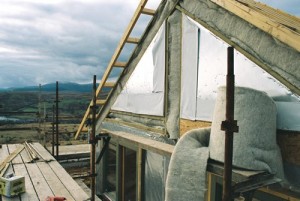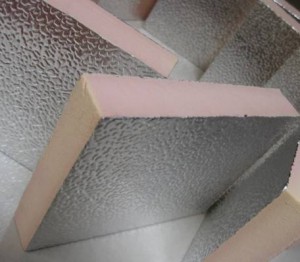Our concern about climate change have led us to an ambitious project. We intend to move our 1930s house into the 21st century by massively reducing its need for active heating.
The main part of this project is improving the insulation. We plan to envelop the entire house in a layer of external wall insulation that keeps the heat inside. For this job, we will use 10 cm thick phenolic insulation board.
You may ask: if you are that concerned about the environment, why are you using a man made material? Why aren’t you going for something natural, like sheep’s wool or straw?
Does it make sense to use a material that ultimately derives from crude oil? Well, for us it does.
Our main restraint is that this project is a retrofit. We are adapting an old house for the future. If we had the means to start from scratch, we probably would choose different materials. As it is, we have a 1930s house that loses heat through its solid brick walls. We need to find a solution that works for us.
The speed at which heat is lost through particular materials is measured in U-values. On average, a solid wall (which is how the main part of the house is built), has a U-value of 2.1. Newly built house walls nowadays have a U-value of 0.3. We are aiming to go better than that, to about 0.23.
What would we have to do to get to that value for different materials?
- phenolic insulation board
- sheep’s wool
– straw bales
1. Sheep’s wool
I love the idea of wrapping my house in a nice warm woollen blanket. Natural materials certainly have an appeal, and for some projects, wool would be the right choice.
For retrofit external wall insulation, however, sheep’s wool isn’t practical. This material works best when it is sandwiched between two structural walls, like the two parts of a cavity wall. We would have to somehow attach the wool to the outside of the existing wall, and then build another structural wall outside that.
The U value of 10 cm of wool is 0.42. In combination with our solid brick wall at a U value of 2.11, that brings us to a total of 0.35, which is above the value we’re aiming for. We would have to make the insulation twice as thick to come to our ideal value.*
2. Straw bales
The advantage of straw bales is that they are structural. In other words, you can build a wall with them and it will stay up. It is a great material to build new structures with, as it also has a high level of air tightness. If we were to start from scratch, this would probably be one of our materials of choice.
However, to get to our ideal U value of about 0.2, we’d need to wrap the house in straw to a thickness of 40 cm. That is rather a lot of straw and would give us very thick walls. We would have to extend the eves of our roof quite a long way to cover this.
3. Phenolic insulation board
Phenolic board is extremely light and easy to work with. So much so, that we are intending to do this part of the installation ourselves. Covered by a mesh and a special render, it is also very durable and flexible.
We will only need 10 cm of phenolic board to come to our overall U value of 0.23. This is a better standard than modern newly built houses.
We calculate that this will be enough to cut out gas central heating all together. With luck, we’ll be able to install the insulation, and the new windows, this year. We need to live with it through the winter to find out how much heating we will actually need.
Here’s hoping that solar hot water, a wood burner, and phenolic insulation board will keep us cosy even in freezing temperatures.
Have you made similar choices? What worked for you? Please share your experiences in the comments below.
*To find out how U values are calculated, click here.



I have a 1960s chalet bungalow where the sloping roof sections in the upstairs rooms only had 2cm of glass fibre fitted. As the gap between plasterboard and tiles was 10cm and I needed to retain ventilation I found that phenolic board was the best solution to improve insulation. It was easy to fit , but di produce a lot of ‘bits’ when cut.
I’ve yet to prove it’s better but I have to assume so.
Sounds like you made the right choice there, Mark.
Retaining ventilation between the insulation and the roof is crucial to prevent condensation and all the troubles that come with that.
I hope you feel a lot warmer come Winter.
Does that external insulation breathe? See Insulation Express on interstitial condensation issues at
http://www.insulationexpress.co.uk/documents/InterstitialCondensationIssues.pdf
“The outer skin of the building should be air tight to meet regulations but
should also be vapour permeable. …
it is very dangerous to use non – permeable external wall insulation”
This http://www.wbs-ltd.co.uk/wetherby-systems/system-components/insulants/phenolic-insulation/ “low water vapour permeance” suggests it won’t breathe, in which case you’ll have to take measures to ensure than any moisture vapour (or moisture) making its way between the building and insulation surface can be both minimised, and allowed escape routes.
Ah… Breatheability might lie in the rendering options “Lime render is preferable as it is breathable.” according to http://www.superhomes.org.uk/resources/insulating-a-solid-wall/
@Antonia – condensation & air-tightness is a crucial issue. We are going for an absolutely air-tight design. Real air-tightness is really hard to achieve, so it’s going to be quite a challenge. In our case, the main air-tight layer will be the existing brick and render wall. Ventilation will be provided by a whole-house heat recovery ventilation system. That recovers heat from stale air as it leaves the house, and uses it to warm up the cool fresh air that’s being pumped in. Once your insulation gets really good, heat loss from ventilation becomes significant, so a system like this becomes worthwhile.
Ideally to prevent condensation, your air-tight layer is on the warm side of your insulation, so external wall insulation is optimal. The quote from Insulation Express seems hyperbolic to me. It sounds like they are selling a breathable external insulation product – you’d need that if your walls were made from straw or rammed earth or some such – those materials need a particular level of humidity in order to retain their strength.